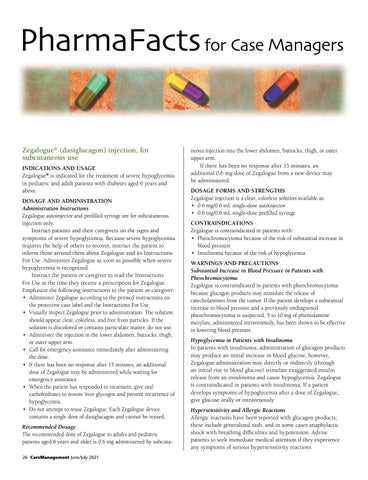PharmaFacts for Case Managers
Zegalogue® (dasiglucagon) injection, for subcutaneous use INDICATIONS AND USAGE Zegalogue® is indicated for the treatment of severe hypoglycemia in pediatric and adult patients with diabetes aged 6 years and above. DOSAGE AND ADMINISTRATION Administration Instructions Zegalogue autoinjector and prefilled syringe are for subcutaneous injection only. Instruct patients and their caregivers on the signs and symptoms of severe hypoglycemia. Because severe hypoglycemia requires the help of others to recover, instruct the patient to inform those around them about Zegalogue and its Instructions For Use. Administer Zegalogue as soon as possible when severe hypoglycemia is recognized. Instruct the patient or caregiver to read the Instructions For Use at the time they receive a prescription for Zegalogue. Emphasize the following instructions to the patient or caregiver: • Administer Zegalogue according to the printed instructions on the protective case label and the Instructions For Use. • Visually inspect Zegalogue prior to administration. The solution should appear clear, colorless, and free from particles. If the solution is discolored or contains particulate matter, do not use. • Administer the injection in the lower abdomen, buttocks, thigh, or outer upper arm. • Call for emergency assistance immediately after administering the dose. • If there has been no response after 15 minutes, an additional dose of Zegalogue may be administered while waiting for emergency assistance. • When the patient has responded to treatment, give oral carbohydrates to restore liver glycogen and prevent recurrence of hypoglycemia. • Do not attempt to reuse Zegalogue. Each Zegalogue device contains a single dose of dasiglucagon and cannot be reused. Recommended Dosage The recommended dose of Zegalogue in adults and pediatric patients aged 6 years and older is 0.6 mg administered by subcuta26 CareManagement June/July 2021
neous injection into the lower abdomen, buttocks, thigh, or outer upper arm. If there has been no response after 15 minutes, an additional 0.6 mg dose of Zegalogue from a new device may be administered.
DOSAGE FORMS AND STRENGTHS Zegalogue injection is a clear, colorless solution available as: • 0.6 mg/0.6 mL single-dose autoinjector • 0.6 mg/0.6 mL single-dose prefilled syringe CONTRAINDICATIONS Zegalogue is contraindicated in patients with: • Pheochromocytoma because of the risk of substantial increase in blood pressure • Insulinoma because of the risk of hypoglycemia WARNINGS AND PRECAUTIONS Substantial Increase in Blood Pressure in Patients with Pheochromocytoma Zegalogue is contraindicated in patients with pheochromocytoma because glucagon products may stimulate the release of catecholamines from the tumor. If the patient develops a substantial increase in blood pressure and a previously undiagnosed pheochromocytoma is suspected, 5 to 10 mg of phentolamine mesylate, administered intravenously, has been shown to be effective in lowering blood pressure. Hypoglycemia in Patients with Insulinoma In patients with insulinoma, administration of glucagon products may produce an initial increase in blood glucose; however, Zegalogue administration may directly or indirectly (through an initial rise in blood glucose) stimulate exaggerated insulin release from an insulinoma and cause hypoglycemia. Zegalogue is contraindicated in patients with insulinoma. If a patient develops symptoms of hypoglycemia after a dose of Zegalogue, give glucose orally or intravenously Hypersensitivity and Allergic Reactions Allergic reactions have been reported with glucagon products; these include generalized rash, and in some cases anaphylactic shock with breathing difficulties and hypotension. Advise patients to seek immediate medical attention if they experience any symptoms of serious hypersensitivity reactions




